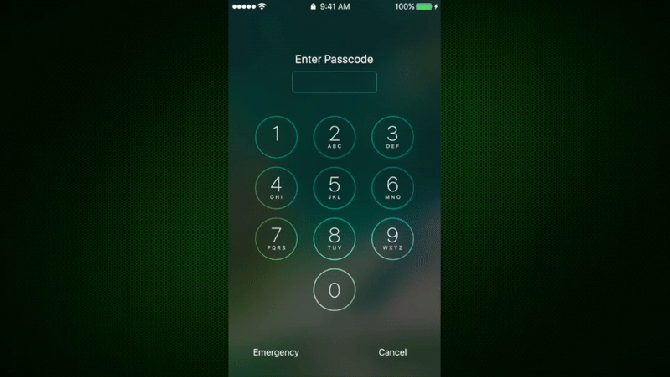Credit: Zack Whittaker
What’s next for ransomware?
Got nothing to hide? Think again.
Privacy is what sets us apart from the animals. It’s also what sets many countries and citizens apart from dictatorships and despots. People often don’t think about their rights until they need them — whether it’s when they’re arrested at a protest or pulled over for a routine traffic stop.
Surveillance is also a part of life, and it’s getting progressively more invasive. Government eavesdropping is increasing, carried out in wider secrecy, and it’s becoming far morelocalized. In fact, the last three presidents have pushed for greater surveillance: Clinton introduced mandated wiretapping laws, Bush expanded mass domestic surveillance, and Obama expanded the intelligence service’s reach — just in time for Trump.
Now, with a new president in the Oval Office, many are concerned about the future of their fundamental freedoms and constitutional rights.
There is no such thing as perfect security. But no matter who you are or where you are in the world, there are a lot of things you can do — many of which are simple — to protect yourself in this turbulent time.
THE SIMPLE STUFF
Your privacy, at its core, relies on your data being secure.
There are some professions — such as government workers, journalists, and activists — who face far more and complex threats than the average citizen, who should usually only worry about tech companies tracking them to serve up the best kinds of ads, or government bulk data collection of their personal records. But everyone can take the basic advice and modify it on varying degrees.
While most apps and services nowadays secure your data with encryption on their servers to prevent data from being readable if hacked or served with a government subpoena, many more now are providing it “end-to-end.” In other words, nobody else can see what’s sent, stored, or received, other than you and the person you’re talking to — not even the companies themselves.
Usually, the only way to break that “end-to-end” model is to attack an endpoint, such as the device you’re using, the internet pipe that the data’s traveling along, or the company’s servers.
If you secure each of those points, you’re well on the way in keeping your data private.
SECURE YOUR DEVICES
Your phone is your ultimate endpoint. You carry it everywhere and it usually holds your most personal secrets and sensitive information.
iPhones are widely seen as the most secure mainstream device today. Modern and newer Android devices usually come with strong security features, but there isn’t a universal implementation of encryption yet. Your iPhone encrypts as soon as you lock your screen(even the feds can’t access it), but Android devices have to be shut down entirely.
Here’s a guide on how to secure your iPhone, and here’s another guide for most Android devices.
TURN OFF FINGERPRINT PHONE UNLOCK
Your Touch ID or fingerprint sensor is meant to keep your data more secure. But in some cases federal agents can force you to unlock your phone with your fingerprint, because the courts have determined that it’s not a violation of the Fifth Amendment, which protects against self-incrimination. The feds however can’t force you to turn over your passcode.
Turn off Touch ID by going to Settings > Touch ID & Passcode > turn off iPhone Unlock. (Android users can go to Settings > Security > Lock Screen or Nexus Imprint.)
BE MINDFUL OF EVERY APP YOU INSTALL
Each time you install an app, it will ask you for permissions to your phone’s features or data, like your contacts, photos, camera, or even the phone dialer itself. Be mindful of apps that you install, as a single rogue app can punch a hole in your privacy protections.
Take Meitu, the anime photo app that whipped up a privacy storm. For such a simple app, it required almost unlimited and unfettered access to your phone. Remember: if an app is free, you’re paying for it in some other way — and usually it’s with your data.
SET A STRONG PASSCODE
Chances are you’re already using a six-digit passcode, if you’re using a modern version of iOS. But you can make the code as long as you like. We have a simple and handy guide here. Choosing the “custom numeric code” will still give you the number keypad on the lock screen, making the passcode entry easier to type in.

USE A COMPUTER? TAKE THIS ADVICE
Keeping your devices and apps up to date will significantly reduce attacks. Every app or service you install will increase your vulnerability risks because no software is perfect. If you have preinstalled apps or “bloatware,” you should remove those — and that includes web plugins like Adobe’s Flash, Oracle’s Java, and Apple’s QuickTime. Using ad-blockers can prevent ads from installing tracking cookies and even malware (which happens surprisinglyoften).
You should also consider encrypting your computer, which is easy if you use either Windows or a Mac. Just make sure you don’t upload your encryption keys to the cloud, otherwise Microsoft or Apple could be forced to turn them over.
Yes, Windows 10 is more secure than Windows 7, but it’s understandable that many think it’s a privacy nightmare. We have a separate Windows 10 privacy guide that shows you the right options for you.
SECURE YOUR MESSAGING
Now that your device is secure, you should think about your data in-transit — that is, as it traverses the waves of the wireless spectrum and the pipes of the internet.
SMS messages and phone calls can be intercepted and wiretapped at any time — it’s the law. Police can also use cell-site simulators (known as “stingrays”) to force-downgrade your cell connection from LTE to non-encrypted channels to make it easier to snoop on your phone.
It’s not just the messages you send that you need to worry about; you also have to think about the data that’s generated as a result — so-called metadata, such as who you’re talking to, when, and sometimes where. That information alone can tell a lot about your life, which is why it’s so important to intelligence services. Metadata is a core pillar of government surveillance.
Countering metadata collection isn’t easy, but its collection can be limited. The trick? Use the right app.
Let’s get one myth out of the way: There is no secure email solution — at least not yet. While there are systems like PGP encryption, which remains the favorite for scrambling the contents of email messages, it’s not as strong as it used to be and better instant communications exist.
In ranked order, best first:
USE SIGNAL FOR ENCRYPTED MESSAGING
Signal is by far the simplest and the most secure app when it’s used properly. Available for iOS and Android, the end-to-end encrypted messenger was almost universally accepted as the gold standard among security experts and professionals after its debut audit.
The messaging app and its desktop counterpart are also open-source, meaning anyone can look at and inspect the code to ensure there are no backdoors. And, Signal almost entirely removes itself from the surveillance loop by collecting almost no metadata. Even if a user chooses to upload their contacts list to Signal, each record is scrambled and can’t be used by the intelligence services.

The Intercept has a simple guide on how to verify your contacts in the unlikely event that your communications are being intercepted. You usually only do this only once (unless you or someone you’re talking to changes device).
You can download Signal here.
IGNORE THE FEARMONGERS. WHATSAPP IS BASICALLY FINE
If you heard recently that WhatsApp has a “backdoor,” that’s wrong. So wrong, in fact, that some of the world’s foremost security experts and cryptographers have called for the story to be retracted. The Guardian, which published the story, later said “flawed reporting” led the newspaper to “overstate the potential impact on the security of users’ messaging.
The end-to-end encrypted messenger, owned by Facebook, works on a range of devices, including desktop. At its core, it uses the same protocols as Signal — so it’s secure and neither Facebook, WhatsApp, or anyone else can read your messages.
WhatsApp is fine as long as it’s being used properly by verifying your keys with the other party. Make sure that you enable security notifications so you can monitor for any key changes.
Do this by going to WhatsApp then Chats > Chat Backup > then set Auto Backup to Off.

You should also turn off online backups — both on the app and iCloud and Android’s settings — as backups can be cherry-picked out of the cloud by law enforcement with a search warrant.
The app does collect and store more metadata than Signal. That means the government, if it demands data from Facebook, could see who you’re talking to and when. A recent report by Forbes confirms that the company could be forced to turn over data it collects, such as IP addresses, phone identifiers, and even location data in some cases.
IMESSAGE IS OK, BUT BE MINDFUL
Apple’s iMessage is also encrypted end-to-end, but you can’t verify your keys with the people you’re messaging. That’s a problem, because you can’t ever be sure that your messages aren’t being intercepted. Recent developments have shown that the system is vulnerable to man-in-the-middle attacks, so don’t rely on the system for critical communications. And again, don’t back up your messages to iCloud, because Apple can be forced to turn that data over to law enforcement. End-to-end encryption refers to your message securely traversing the internet and not when it’s in storage.
That said, you should regularly carry out an encrypted local backup your iPhone or iPad on occasion. It’s very simple to do, and can restore your data if you break your device.
AS FOR ENCRYPTED EMAIL…
Again, encrypted email is a fallacy, so you should get the idea out of your head. Consider services that don’t require you to handle private keys, such as ProtonMail, which now comes with support for the Tor browser (more on that shortly).
Or, there’s still PGP, which remains clunky and difficult to use for even many advanced users. Even the creator of PGP admits he doesn’t use it anymore. If you really want to use PGP, get started with these Windows or Mac guides from the Electronic Frontier Foundation.
Or, if you can get an invite to Keybase.io (you can find some here or by searching Twitter), you can choose to import your PGP private key and use the web-based encrypt and decrypt tools. This has raised some eyebrows, but it’s entirely optional, as it makes scrambling and unscrambling PGP messages and files significantly easier.
SECURE YOUR BROWSING
Browsing is usually at the heart of what most people do. But just as you’re looking out at the world, you also have a lot trying to look in. Ad networks will track you from site to site, your internet provider will log which pages you visit, and hackers will try to target you.
Without getting too into the weeds, no browser is perfect, but some are better than others.
When it comes to the gold standard of privacy, consider using Tor. It’s like a regular browser with privacy benefits, and it’s often used by the privacy conscious, such as reporters and activists.





